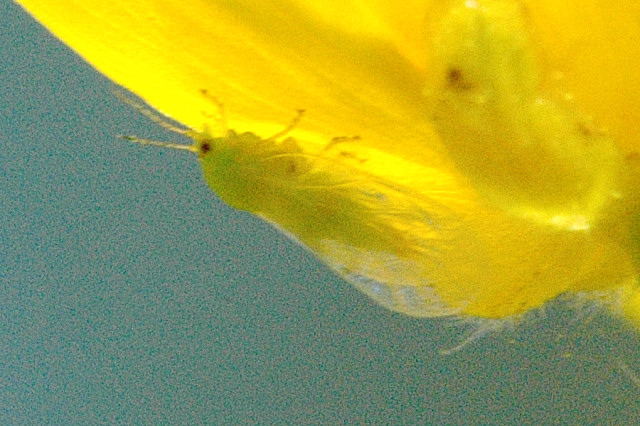- Jumping plant louse
Taxobox
name = Psyllidae

image_caption = "Psylla alni "
image_width = 250px
regnum =Animal ia
phylum =Arthropod a
classis =Insect a
ordo =Hemiptera
subordo =Sternorrhyncha
superfamilia =Psylloidea
familia = Psyllidae
subdivision_ranks = Genera
subdivision = 71 generaPsyllids or jumping plant lice are small plant-feeding insects that tend to be very "host specific", i.e. they only feed on one plant species (monophagous) or feed on a few related plants (oligophagous). Together with
aphid s, phylloxerans,scale insect s and whiteflies they form the group calledSternorrhyncha , which is considered to be the most "primitive" group within the "true bugs" (Hemiptera ). They have traditionally been considered a single family, Psyllidae, but recent classifications divide the group into six families; the present restricted definition still includes 71 genera in the Psyllidae.Psyllid fossils have been found from the early
Permian before theflowering plants evolved. The explosive diversification of the flowering plants in theCretaceous was paralleled by a massive diversification of associated insects, and many of the morphological and metabolic characters that the flowering plants exhibit may have evolved as defenses against herbivorous insects.Several genera of psyllids, especially among the
Australia n fauna, secrete coverings called "lerps" over their bodies, presumably to conceal them frompredator s and parasites.Coevolution
Insect-plant interactions have been important in defining models of
coevolution andcospeciation , referring to whether plant speciation drives insect speciation and vice versa, though most herbivorous insects probably evolved long after the plants they feed on.Citrus greening, caused by a bacterium "
Liberibacter asiaticum " is an example of a plant pathogen that has coevolved with its insect vector, the Asian Citrus Psyllid, AsCP, "Diaphorina citri ", such that the pathogen causes little or no harm to the insect, but causes a major disease which can reduce citrus quality, flavor, and production as well as causing citrus trees to die. The AsCP was found in Florida in 1998, and has since spread across the southern U.S. into Texas. This disease, also known as Huanglongbing, was found in Florida citrus groves in 2005. Management methods to reduce the spread of this disease and psyllid populations depend on an Integrated Pest Management approach using insecticides, parasitoids, predators, and pathogens specific to the AsCP.External links
on the
UF / IFAS Featured Creatures Web site* [http://creatures.ifas.ufl.edu/trees/eucalyptus_psyllids.htm "Blastopsylla occidentalis", eucalyptus psyllid]
* [http://creatures.ifas.ufl.edu/beneficial/b_melaleucae.htm "Boreioglycaspis melaleucae"]
* [http://creatures.ifas.ufl.edu/trees/false-mastic_psylla.htm "Ceropsylla sideroxyli", false-mastic psylla]
* [http://creatures.ifas.ufl.edu/citrus/acpsyllid.htm "Diaphorina citri", Asian citrus psyllid]
* [http://creatures.ifas.ufl.edu/trees/eucalyptus_psyllids.htm "Glycaspis brimblecombei", red gum lerp psyllid]
* [http://creatures.ifas.ufl.edu/trees/hackberry_psyllid.htm "Pachypsylla venusta", hackberry petiole gall psyllid]
* [http://creatures.ifas.ufl.edu/fruit/persimmon_psylla.htm "Trioza diospyri", persimmon psylla]
* [http://creatures.ifas.ufl.edu/orn/trees/red_bay_psyllid.htm "Trioza magnoliae", red bay psyllid]
Wikimedia Foundation. 2010.
